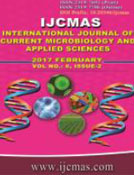


 National Academy of Agricultural Sciences (NAAS)
National Academy of Agricultural Sciences (NAAS)

|
PRINT ISSN : 2319-7692
Online ISSN : 2319-7706 Issues : 12 per year Publisher : Excellent Publishers Email : editorijcmas@gmail.com / submit@ijcmas.com Editor-in-chief: Dr.M.Prakash Index Copernicus ICV 2018: 95.39 NAAS RATING 2020: 5.38 |
Phenol is a toxic hydrocarbon for nervous system, kidneys, liver, muscles and immune system. It is also mutagenic and possibly carcinogenic. Phenol containing- pollutants are dangerous and spread worldwide in the industrial effluents.The present study aimed to isolate a potent microorganism able to degrade phenol, as well as to evaluate the nutritional and environmental conditions that lead to its maximum degradation. A yeast isolated from petroleum-contaminated soil on MSM supplemented with phenol as sole carbon source, was identified by 28S rDNA sequencing. Residual phenol was estimated using 4-AAP method and the growth of yeast was measured spectrophotometrically at 600 nm. Candida tropicalis H was found to be highly effective for the removal of phenol. Phenol degradation was approximately 92.89 % of an initial concentration of 2000 mg phenol l-1 at 30°C in shaken culture (100 rpm) after 3 days incubation. After the application of Plackett-Burman design, 99.91 % degradation of phenol was achieved. The most effective factors influencing phenol degradation, among studied 11 variables, were K2HPO4 and culture volume. Candida tropicalis H could be a good candidate for the bioremediation of phenol contaminants in heavily polluted sites. A phytotoxicity study revealed that the biodegradation of phenol resulted in its detoxification, which indicated a possible use of phenol containing-effluents in the irrigation of plants after bioremediation process.
 |
 |
 |
 |
 |